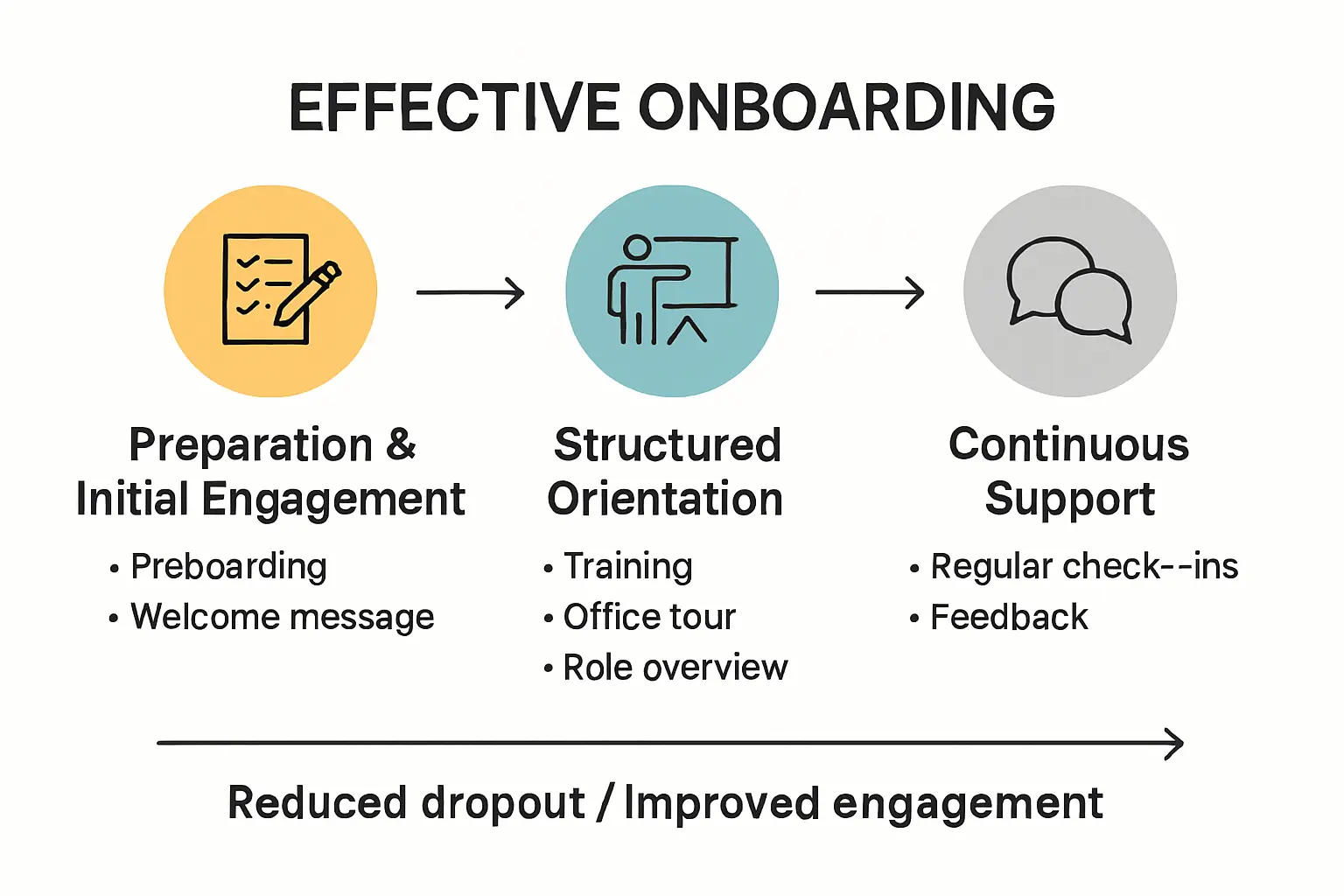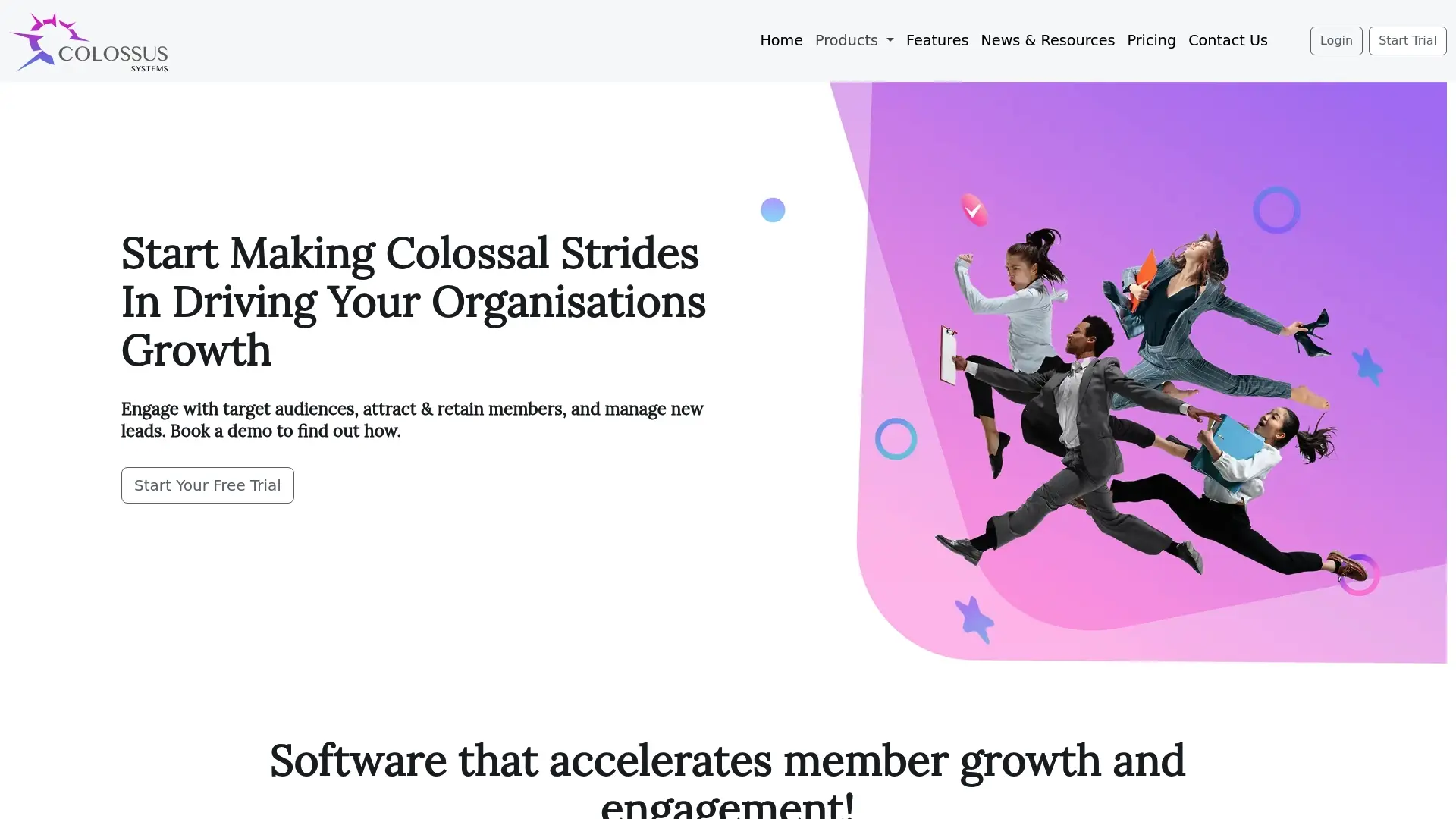Essential Guide to Onboarding New Members Successfully

Every organisation wants new members to feel at home right from the start. You might expect most people to settle in quickly and join in, but research shows that up to 20 percent of new members drop out within the first 45 days. That sounds discouraging, yet the solution is surprisingly simple: a carefully planned onboarding experience can turn those early dropouts into some of your most loyal advocates.
Table of Contents
- Why Onboarding New Members Matters
- Key Steps For Effective Onboarding
- Engaging New Members From Day One
- Overcoming Common Onboarding Challenges
Quick Summary
| Takeaway | Explanation |
|---|---|
| Successful onboarding enhances member retention. | Effective onboarding sets the tone for long-term engagement, making members feel welcomed and valued from the outset. |
| Personalised experiences improve initial engagement. | Tailored communications and resources help new members feel special, fostering a stronger connection with the organisation. |
| Structured support reduces early dropout rates. | Providing clear expectations and continuous support helps new members adjust and feel integrated, lowering chances of disengagement. |
| Regular check-ins sustain member enthusiasm. | Ongoing communication and feedback are crucial to maintain interest and ensure that members feel supported throughout their journey. |
| Address psychological barriers to integration. | Recognising challenges like imposter syndrome and communication anxiety allows organisations to create more inclusive and supportive environments. |
Why Onboarding New Members Matters
Successful onboarding represents the critical first interaction that transforms potential members into engaged, committed participants within an organisation. This initial experience sets the foundation for long-term membership retention, organisational commitment, and overall community engagement.
The Strategic Importance of First Impressions
First impressions are paramount in membership experiences. Learn more about building strong member connections by understanding how initial interactions shape future relationships. According to Old Dominion University, effective onboarding processes directly correlate with higher satisfaction, commitment, and performance across organisational contexts.
Research demonstrates that organisations with structured onboarding approaches experience significantly improved member engagement. The National Center for Biotechnology Information highlights that comprehensive onboarding processes enhance psychological safety and create environments where new members feel genuinely welcomed and valued. This psychological comfort translates into increased participation, reduced anxiety, and a stronger sense of belonging.
Building Long-Term Organisational Commitment
The University of Minnesota’s Office of Human Resources emphasises that well-planned onboarding helps new members adjust more seamlessly to their roles and responsibilities. By providing clear expectations, resources, and support during initial interactions, organisations can dramatically reduce early dropout rates and foster a sense of community.
Key elements of successful onboarding include:
- Clear Communication: Providing transparent information about membership benefits, expectations, and opportunities
- Personalised Welcome: Creating individualised experiences that make new members feel uniquely valued
- Structured Integration: Offering guided pathways for participation and engagement
Moreover, effective onboarding goes beyond mere administrative procedures. It represents a strategic investment in human connection, transforming transactional interactions into meaningful relationships. By prioritising intentional, empathetic onboarding processes, organisations can create vibrant, dynamic communities where members feel genuinely connected and motivated to contribute.
The data consistently demonstrates that organisations investing time and resources into thoughtful onboarding strategies experience substantial returns. Members who feel supported from their initial interactions are more likely to remain engaged, participate actively, and become long-term advocates for the organisation’s mission and values.
Key Steps for Effective Onboarding
Navigating the complex landscape of member onboarding requires a strategic, systematic approach that transforms initial contact into meaningful engagement. Successful onboarding is not a single event but a carefully orchestrated process that involves multiple interconnected steps.
Preparation and Initial Engagement
Before new members officially join, organisations must lay the groundwork for a welcoming and informative experience. Discover strategies for membership integration that set the stage for long-term participation. According to research from Harvard Business Review, the first 90 days are critical in establishing member expectations and organisational culture.
Initial preparation involves several key components:
- Pre-Arrival Communication: Send personalised welcome emails, information packets, and clear instructions about next steps
- Technology Setup: Provide immediate access to necessary digital platforms and resources
- Preliminary Information Gathering: Collect relevant background details to tailor the onboarding experience
Structured Orientation and Integration
The Society for Human Resource Management emphasises the importance of a comprehensive orientation programme that goes beyond basic administrative procedures. Effective integration involves creating multiple touchpoints that help new members understand the organisation’s mission, values, and potential opportunities for involvement.
Key integration strategies include:
- Comprehensive Welcome Session: Host an interactive orientation that introduces organisational structure, key personnel, and membership benefits
- Mentorship Matching: Pair new members with experienced participants who can provide guidance and support
- Clear Pathway Mapping: Outline potential engagement routes, committees, and advancement opportunities
Continuous Support and Engagement
Onboarding does not conclude after the initial weeks. Sustained support is crucial for maintaining member enthusiasm and commitment. Organisations must develop ongoing engagement mechanisms that continuously demonstrate value and foster a sense of belonging.
Implement follow-up strategies such as:
- Regular Check-ins: Schedule structured conversations to assess member satisfaction and address potential concerns
- Personalised Communication: Send targeted information based on individual member interests and professional backgrounds
- Feedback Mechanisms: Create easy channels for members to share their experiences and suggestions
By approaching onboarding as a holistic, dynamic process, organisations can transform initial interactions into long-lasting, mutually beneficial relationships.
To help readers understand and implement the onboarding process, here is a summary table outlining the key steps for effective onboarding, along with practical actions for each phase:
| Step | Key Actions |
|---|---|
| Preparation and Initial Engagement | Pre-arrival communication, technology setup, information gathering |
| Structured Orientation and Integration | Welcome session, mentorship matching, pathway mapping |
| Continuous Support and Engagement | Regular check-ins, personalised communication, feedback mechanisms |

The goal extends beyond mere administrative compliance to creating genuine connections that inspire ongoing participation and organisational loyalty.

Engaging New Members from Day One
Successful member engagement begins with the very first interaction, transforming initial contact into a robust, meaningful relationship. The critical window of the first few days sets the tone for long-term participation and organisational commitment.
Creating a Personalised Welcome Experience
Explore strategies for sustaining member interest from the moment they join. According to the American Society of Association Executives, personalised communication within the first 90 days is paramount for member retention.
Effective personalisation strategies include:
- Tailored Welcome Communications: Craft individualised emails addressing specific interests and potential engagement opportunities
- Immediate Access to Resources: Provide instant digital platform entry and comprehensive membership materials
- Targeted Initial Interactions: Design welcome experiences that reflect the member’s professional background and organisational objectives
Establishing Early Connections and Expectations
The University of Minnesota’s Human Resources guidance emphasises establishing clear performance expectations and maintaining consistent communication. By creating structured yet flexible initial interactions, organisations can help new members feel valued and understand their potential contributions.
Key connection strategies involve:
- Structured Initial Meetings: Conduct comprehensive orientation sessions that outline organisational culture and membership pathways
- Mentorship Programmes: Match new members with experienced participants who can provide guidance and insights
- Clear Performance Frameworks: Define 3-5 key expectations that connect individual contributions to broader organisational goals
Sustaining Engagement Through Continuous Support
The National Rural Health Resource Center recommends implementing ongoing support mechanisms that extend beyond initial welcome processes. Continuous engagement requires proactive, thoughtful approaches that demonstrate the organisation’s commitment to member success.
Implement these sustained engagement techniques:
- Regular Check-ins: Schedule structured conversations to assess member satisfaction and address emerging needs
- Feedback Mechanisms: Create accessible channels for members to share experiences and suggestions
- Progressive Skill Development: Offer learning opportunities that align with members’ professional development objectives
By prioritising intentional, responsive engagement from day one, organisations can transform initial interactions into enduring, mutually beneficial relationships. The goal transcends administrative procedures, focusing instead on creating genuine connections that inspire ongoing participation and organisational loyalty.
Successful member engagement is an art of balance: providing structure while remaining flexible, offering support without overwhelming, and demonstrating value through consistent, meaningful interactions.
Overcoming Common Onboarding Challenges
Onboarding new members presents organisations with multifaceted challenges that require strategic, empathetic approaches to successfully integrate individuals into their community. Understanding and proactively addressing these potential barriers is crucial for creating a welcoming, supportive environment that encourages long-term engagement.
Navigating Social and Psychological Barriers
Learn more about building inclusive membership experiences that address complex integration challenges. According to research from the National Library of Medicine, new members often experience significant stress and anxiety during initial integration periods, which can dramatically impact their willingness to participate and remain engaged.
Key psychological challenges include:
- Imposter Syndrome: Managing feelings of inadequacy or uncertainty about belonging
- Communication Anxiety: Overcoming hesitation to interact with established members
- Cultural Adaptation: Understanding unwritten organisational norms and expectations
Developing Effective Support Mechanisms
Addressing these challenges requires comprehensive, multifaceted support strategies. Organisations must create structured frameworks that provide emotional and practical assistance during the critical early stages of membership.
Effective support approaches involve:
- Peer Mentorship Programmes: Pairing new members with experienced participants who can provide guidance and emotional support
- Structured Orientation Workshops: Designing interactive sessions that build confidence and provide clear pathways for engagement
- Flexible Communication Channels: Establishing multiple ways for new members to ask questions and seek assistance
Implementing Targeted Intervention Strategies
Proactive intervention can significantly mitigate potential barriers to successful onboarding. By anticipating and addressing common challenges, organisations can create more resilient, inclusive membership experiences.
Targeted intervention strategies include:
- Personalised Onboarding Plans: Developing individualised approaches that recognise unique member backgrounds and potential integration challenges
- Regular Performance Feedback: Providing constructive, supportive guidance that helps members understand their progress and potential
- Continuous Learning Opportunities: Offering resources that help members develop skills and overcome initial hesitations
Successful onboarding transcends administrative procedures. It represents a holistic approach to member integration that acknowledges individual experiences, provides robust support, and creates an environment where every member feels valued, understood, and empowered to contribute meaningfully.
By recognising that each new member brings unique perspectives, challenges, and potential, organisations can transform potential barriers into opportunities for growth, connection, and mutual understanding. The key lies in maintaining a flexible, empathetic approach that prioritises individual experiences while supporting collective organisational objectives.
For quick reference, the following table outlines common onboarding challenges and recommended support strategies discussed in the article:
| Onboarding Challenge | Recommended Support Strategies |
|---|---|
| Imposter Syndrome | Peer mentorship programmes |
| Communication Anxiety | Flexible communication channels |
| Cultural Adaptation | Structured orientation workshops |
| Unclear Expectations | Personalised onboarding plans, clear performance frameworks |
| Early Disengagement | Regular performance feedback, continuous learning opportunities |
Frequently Asked Questions
What is the importance of successful onboarding for new members?
Successful onboarding is crucial as it sets the stage for long-term engagement and retention. A well-planned onboarding process helps new members feel welcomed and valued, reducing the likelihood of early dropouts.
How can personalised welcome experiences enhance member engagement?
Creating personalised welcome experiences, such as tailored communications and immediate access to resources, helps new members feel special and fosters a stronger connection with the organisation right from the start.
What are the key steps involved in effective onboarding?
Key steps in effective onboarding include preparation and initial engagement, structured orientation and integration, and continuous support and engagement to maintain enthusiasm among new members.
How can organisations overcome common onboarding challenges?
Organisations can overcome common challenges by implementing peer mentorship programmes, flexible communication channels, structured orientation workshops, and personalised onboarding plans that address unique member needs.
Transform Your Onboarding Process and Never Lose New Members Again
Struggling to keep new members engaged after those crucial first weeks? This article has shown how easy it is for members to feel lost or disconnected without a structured, personalised onboarding experience. If you have faced early member dropouts, confusion over expectations, or gaps in continuous support, you are not alone. These are common pain points for any membership-focused organisation. You need more than a welcome email. What you really need is a comprehensive system that brings together communication, event planning, targeted marketing and integrated feedback to ensure your members feel supported right from day one.

With Colossus Systems, you will discover a single, easy-to-use platform built to tackle every onboarding challenge discussed here. Use our smart CRM to tailor welcome journeys, streamline orientation through event portals, and keep engagement high with ongoing updates and analytics. Your team can automate check-ins, personalise member interactions, and collect feedback with zero hassle. Do not let another new member slip away. Book a demo or learn more today and build a thriving, loyal membership that grows with your organisation.
Recommended
- Growing Your Memberships Sustainably: 6 Principles To Live By |CS
- [The Benefits of Integrating Job Boards into Membership Organisations